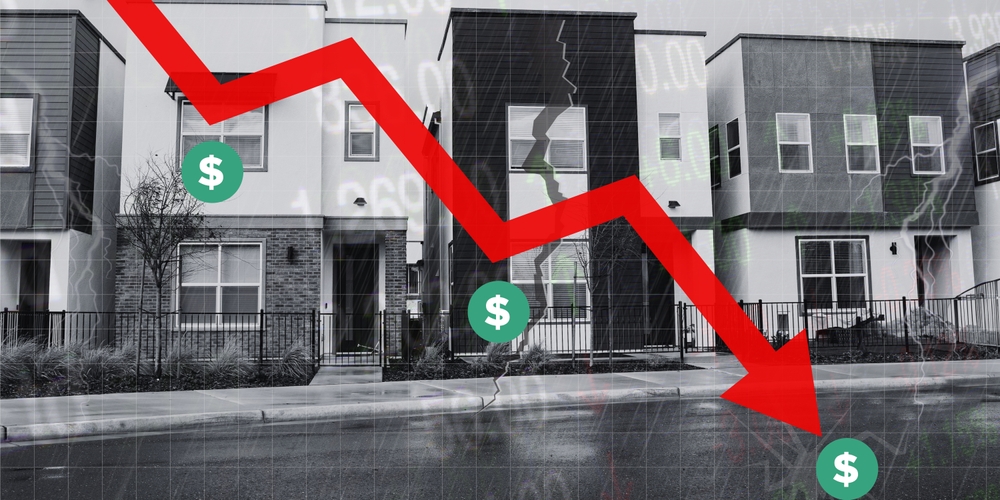In a high-rate mortgage environment like the one we’re currently experiencing, it can be very tempting to choose an adjustable-rate mortgage (ARM) loan instead of a fixed-rate mortgage loan. The hope is that you get a slightly lower rate for the short term, and by the time you need to convert it to a fixed-rate loan, loan rates will have dropped, and you will be able to lock in a lower rate.
However, while adjustable-rate mortgages may save you money initially, they tend to be more complicated than fixed-rate loans, can make budgeting more challenging, and may not save you much money in the long run. An ARM can make sense for those looking for a short-term mortgage or to take advantage of declining rates. 
Fixed-rate loans can give you cost certainty with consistent payments throughout the loan. It makes them perfect for new homebuyers who want a simple, easy-to-understand lending product. It also helps you avoid fluctuations in the rate market, but it might make taking advantage of declining rates more difficult and costly.
Here is everything you need to know about adjustable-rate mortgage loans vs. fixed-rate mortgage loans.
Key Takeaways
|
What is an Adjustable-Rate Mortgage
An adjustable-rate mortgage is a home loan with an interest rate that can change over the life of the loan. The mortgage contract sets the time and amount the rate can adjust.
Here is how an ARM loan works:
Initial Fixed-Rate Period
- The loan will start with a period where the rate will not change from the initial rate. This initial period will usually be 3, 5, 7 or 10 years.
- These loans are named by combining the length of the initial rate period and the frequency of rate adjustments after that initial period, separated by a slash. For example, a rate with an initial 5-year period with annual adjustments after those 5 years is called a 5/1 ARM.
- Overall loan terms are similar to fixed-rate mortgage loans, with 10, 15, 20 and 30-year mortgages most common.
Adjustment Period
- Once adjustments start, they will occur on a pre-determined schedule. In our example 5/1 ARM above, they would occur annually after the initial 5-year period ends.
- The adjustment is determined by whichever benchmark interest rate the lender uses. The lender will also add a margin to that benchmark rate to determine your new rate.
- For example, if your initial rate was 6%, and the benchmark rate is 4.5% at the first adjustment, and the margin is 2%, your new rate would be 6.5%.
Adjustment Caps
- Initial adjustment cap: This cap will limit how much the rate can increase or decrease at the first adjustment.
- Periodic adjustment cap: This cap limits how much the rate can increase or decrease at any later adjustment.
- Lifetime cap: This limits how much the rate can increase or decrease over the life of the loan.
Pros and Cons of Adjustable-Rate Mortgages
| Pros | Cons |
| Initial rates are lower than fixed-rate mortgage loans, saving money initially on payments | Payments can fluctuate greatly as rates increase or decrease |
| If benchmark rates stay steady or decline, you may save money throughout the life of the loan | ARM loans are complicated and often hard for new borrowers to understand |
| Great if you plan to sell your house in the next few years before the first adjustment hits | Out-of-pocket costs may be greater, as you often need a larger down payment for ARM loans |
What is a Fixed-Rate Mortgage
A fixed-rate mortgage is a home loan where the rate stays the same over the life of the loan. This allows payments to remain relatively stable, allowing for easier budgeting for homeowners.
Here are the key features of fixed-rate mortgage loans:
Fixed Interest Rate
- The rate is locked in when the loan is closed and remains the same until the loan is paid off. This keeps monthly payments consistent throughout the life of the loan.
- Note: Monthly payments can fluctuate slightly if your lender includes escrowed property tax and home insurance payments in your overall payment.
Loan Term
- Mortgage loans are typically 10, 15, 20 or 30 years long.
- Interest rates typically increase with the longer loan term.
- Your payment will be lower with a longer-term loan, but you will pay more in interest over the life of the loan.

Monthly Payment
- The monthly payment will include the interest accrued since the last payment, your escrowed property taxes and home insurance, and potentially private mortgage insurance (PMI). The rest is applied to the loan’s principal balance.
- To increase the available equity in your home and pay your loan off sooner, pay extra if possible when making your monthly payment. The excess above your standard payment will be applied to the principal balance.
| NOTE: In addition to escrowed property tax and home insurance costs, your payment may include private mortgage insurance (PMI) if you have borrowed more than 80% of the home’s value. This will increase your payments regardless of which type of loan you choose. You can request PMI to be removed once you reach 20% equity in your home, and it must be removed once the loan balance reaches 78% of the original home value. |
Pros and Cons of Fixed-Rate Mortgages
| Pros | Cons |
| With fixed rates, your payment will stay consistent throughout the loan, with only slight fluctuations due to taxes and insurance | Fixed-rate loans will have higher initial interest rates than ARM loans, making the monthly payment slightly higher at first |
| Fixed-rate mortgage loans are much more straightforward, making them easier to understand | If rates drop, you may have to refinance to take advantage of lower rates, which can be costly with additional closing fees of a refinance |
| With rates locked, you don’t have to worry about interest rates increasing during the life of your loan like with ARM loans | A higher initial payment may make it harder to qualify if your debt-to-income is close to the lender’s limit for a mortgage loan |
When to Choose an Adjustable-rate Mortgage
Choosing an adjustable-rate mortgage loan may be the right option for you. Here are several examples of when it might be better to choose an adjustable-rate mortgage over a fixed-rate mortgage:
- When rates are forecasted to decline: When your rate adjusts, it goes to whatever the new benchmark rate is plus a margin set by the lender. However, if the benchmark rate drops before the adjustment period, your rate may decline at adjustment instead of increase.
- When a lower monthly payment helps with debt-to-income calculations: Because ARM loans have lower introductory rates and, therefore, lower monthly payments than fixed-rate loans, adjustable-rate loans and their lower initial monthly payment could help the borrower meet the lender’s required debt-to-income ratio.
- When the home you are buying isn’t your forever home: Whether the house you’re buying isn’t big enough for your family to expand, or if your job moves you around the country regularly, if you aren’t going to have this mortgage for very long, getting the lowest possible payment makes the ARM loan make a lot of sense.
- If covering a larger down payment isn’t a problem: Most ARM loans require a larger down payment than fixed-rate loans. Be sure you have the funds to cover the extra down payment.
When to Choose a Fixed-Rate Mortgage
While a lower initial rate makes ARM loans enticing, there are times when it makes more sense to choose a fixed-rate loan instead. Here are several examples of when you should lock your rate in:
- When rates are forecasted to increase: If rates go up, your adjustable-rate loan’s interest rate will also increase. While there is a cap on how high a rate can go, that can cause your monthly payment to skyrocket. If rates are low, lock in a low rate with a fixed-rate mortgage.
- If you are a first-time homebuyer: Fixed-rate mortgages are much more straightforward than adjustable-rate mortgages. Choose a fixed-rate loan to keep the mortgage process as simple for first-time buyers as possible. Also, many first-time homebuyer programs only allow you to choose a fixed-rate mortgage.
- If you’re buying your forever home: If you think you’ll keep your mortgage for a long time, lock in a good rate and leave it. It becomes a set-it-and-forget-it situation.
- If you don’t have as much money for a down payment: Fixed-rate mortgage loans often require a smaller down payment than an ARM loan. If initial funds are tighter, choose a fixed-rate loan.
| NOTE: Just because you choose a fixed-rate mortgage loan doesn’t mean your payment will stay the same throughout the life of the loan. If your lender includes escrowed property tax and home insurance payments in your mortgage payment, your overall payment will fluctuate annually as those expenses change. |
Bottom Line
If you are looking for a simple, set-it-and-forget-it mortgage solution for your new home purchase, a fixed-rate mortgage loan makes sense. It gives you more steady payments, requires a lower down payment, and is far easier to understand than an adjustable-rate mortgage loan. However, if you want to take advantage of a declining rate environment or plan to move on from your home within the next few years, you can save money in the short term with an ARM loan.


